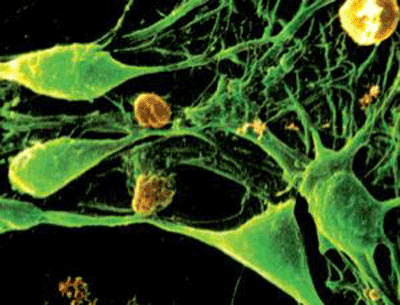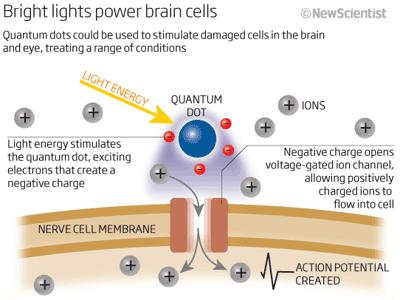Researchers control neurons using quantum dots
Breakthrough study could cure blindness, Alzheimer’s, more
Using tiny semiconductor particles called quantum dots, a team of researchers at the University of Washington has discovered a targeted way to stimulate neurons in the brain.

Quantum dots have displayed the ability to control nerve cells. Being able to switch neurons off and on is very important to not only understanding, but, ultimately, treating brain disorders like Parkinson’s disease, Alzheimer’s, and depression.
“Many brain disorders are caused by imbalanced neural activity,” says electrical engineer Lih Lin of the University of Washington, who worked on this study along with biophysicist Fred Rieke, UW graduate student Katherine Lugo, and former graduate student Xiaoyu Miao. “Manipulation of specific neurons could permit the restoration of normal activity levels.”
How other brain stimulation methods compare
Right now, there are several methods to stimulate the brain out there. The problem, however, is that they also have drawbacks.
Deep brain stimulation, for example, which is used to treat Parkinson’s diseases, requires placing electrodes within the brain. Effective, yes, but the treatment is very invasive.
There’s also transcranial magnetic stimulation, which involves placing electrodes outside the head. Non-invasive, yes, but it’s not targeted, therefore results are less than optimal.
Shedding a little light on a new approach
Researchers are now looking at photostimulation as a non-invasive, yet highly precise way to stimulate brain activity.
One form of treatment that has a lot of researchers excited is optogenetics. This method involves controlling genetically modified brain cells with light. The problem, though, is the whole “genetically modified” part; as such, this technique is not considered safe for humans.
Another form of treatment could be using quantum dots. They are light-sensitive, semiconducting particles which measure just a few billionths of a meter across. What makes quantum dots unique is that they confine electrons within three spatial dimensions, and when these trapped electrons are excited by electricity, they emit light at very precise wavelengths (determined by size and material of dot). Due to the high level of specificity with which you can use them, quantum dots are now being explored for a variety of applications, including lasers, solar cells, light-emitting diodes, and medical imaging devices.
In an effort to see if this technology would be viable as a nerve stimulator, the UW began their research by cultivating prostate cancer cells on a film covered with quantum dots. With the cell membranes positioned right next to the dots, Lin and team shown flashes of light at various wavelengths onto the nanoparticles. Energy from the light excited the quantum dots’ electrons, which caused the surrounding area to become negatively charged. This is where things got interesting. You see, the cells’ ion channels are mediated by a voltage. The change in charge of the surrounding area caused the channels to open, which allowed ions to rush in and out of the cells.

Quantum dots could one day provide a non-invasive treatment for conditions such as Alzheimer’s disease, depression and epilepsy.
“We tried prostate cancer cells first because a colleague happened to have the cell line and experience with them, and they are resilient, which is an advantage for culturing on the quantum dot films,” Lin explains. “But eventually we want to use this technology to study the behavior of neurons, so we switched to cortical neurons after the initial success with the cancer cells.”
Nerve cells are similar in that you need to open up the ion channels in order to generate action potentials (the signals that the nerve cells use to communicate with the brain). If the voltage charge is large enough, an action potential is generated.
When the UW team repeated their experiment with cortical neurons, they discovered that stimulating the quantum dots again caused the ion channels to open, at which point the nerve cells fired up.
Getting the quantum dots to the brain tissue
Lin claims that delivering quantum dots to ailing brain tissue is not that hard.
“A significant advantage is that their surface can be modified with various molecules,” she says, suggesting that molecules could be attached to the quantum dots to target specific brain cells. In terms of non-invasiveness, these molecules could be administered intravenously.
The headache for this new technique is finding a way to shine light on the quantum dot-targeted portion of the brain, without opening up the skull (that would defeat the whole non-invasive approach that the team is going for here). Researchers are confident that this is not that big of an issue, though, saying that it just needs a little creative thinking.
Outlook
One part of the body where quantum dots could work right away is the eye, a natural absorber of light. Specifically, Lin foresees them being put to work in reactivating damaged cells in the retina. The procedure could possibly cure retinal diseases, and even reverse blindness.
To date, quantum dots have only been applied to cells outside the body. To see just how well this approach works, and determine if it is clinically useful, it needs to be performed within living tissue. In order to do this, these dots need to be nontoxic, unlike those used in the Biomedical Optics Express report, where this study was first published (in some instances the quantum dots had detrimental effects on the cells to which they were attached). “One solution would be developing nontoxic quantum dots using silicon,” Lin suggests.
She goes on to conclude, “Based on what we have observed, we are optimistic about the potential of this technology in helping us [answer] biological questions, and eventually diagnose and treat human diseases.” ■
Images via : newscientist.com/article/dn21475-quantum-dots-control-brain-cells-for-the-first-time.html
Story via : osa.org/About_Osa/Newsroom/News_Releases/Releases/02.2012/Flipping-a-Light-Switch-in-the-Cell.aspx
Advertisement
Learn more about Electronic Products Magazine





